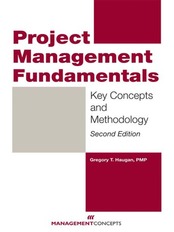Project Management Fundamentals 2nd Edition
Key Concepts and Methodology
Gregory T. Haugan (Author)
Publication date: 10/01/2010
Build on the Right Fundamentals for Project Management Success!
To achieve success in any endeavor, you need to understand the fundamental aspects of that endeavor. To achieve success in project management, you should start with Project Management Fundamentals: Key Concepts and Methodology, Second Edition.
This completely revised edition offers new project managers a solid foundation in the basics of the discipline. Using a step-by-step approach and conventional project management (PM) terminology, Project Management Fundamentals is a commonsense guide that focuses on how essential PM methods, tools, and techniques can be put into practice immediately.
New material in this second edition includes:
• A thorough discussion of agile project management and its use in real-life situations
• Detailed explanations of the unique factors involved in managing service projects
• An enhanced appendix on management maturity models
• A new appendix on project communications and social networking
• Expanded coverage of the triple constraints in PM, going beyond scope, schedule, and cost to include quality, resources, and risks
As a refresher for the experienced project manager or as a comprehensive introductory guide for the new practitioner, Project Management Fundamentals: Key Concepts and Methodology, Second Edition, is the go-to resource that delivers.
To achieve success in any endeavor, you need to understand the fundamental aspects of that endeavor. To achieve success in project management, you should start with Project Management Fundamentals: Key Concepts and Methodology, Second Edition.
This completely revised edition offers new project managers a solid foundation in the basics of the discipline. Using a step-by-step approach and conventional project management (PM) terminology, Project Management Fundamentals is a commonsense guide that focuses on how essential PM methods, tools, and techniques can be put into practice immediately.
New material in this second edition includes:
• A thorough discussion of agile project management and its use in real-life situations
• Detailed explanations of the unique factors involved in managing service projects
• An enhanced appendix on management maturity models
• A new appendix on project communications and social networking
• Expanded coverage of the triple constraints in PM, going beyond scope, schedule, and cost to include quality, resources, and risks
As a refresher for the experienced project manager or as a comprehensive introductory guide for the new practitioner, Project Management Fundamentals: Key Concepts and Methodology, Second Edition, is the go-to resource that delivers.
Formats
Paperback - $52.95 - Members: $47.66
Paperback - $52.95 - Members: $47.66
PDF eBook - $52.95 - Members: $37.07
ePub - $52.95 - Members: $37.07
Find out more about our Bulk Buyer Program
- 10-49: 20% discount
- 50-99: 35% discount
- 100-999: 38% discount
- 1000-1999: 40% discount
- 2000+ Contact ( bookorders@bkpub.com )
Orders of 10+ copies shipping to one address receive free ground shipping
within the U.S. Shipping to separate individual addresses via USPS media mail will be applied a handling fee:
Book Details
Overview
Build on the Right Fundamentals for Project Management Success!
To achieve success in any endeavor, you need to understand the fundamental aspects of that endeavor. To achieve success in project management, you should start with Project Management Fundamentals: Key Concepts and Methodology, Second Edition.
This completely revised edition offers new project managers a solid foundation in the basics of the discipline. Using a step-by-step approach and conventional project management (PM) terminology, Project Management Fundamentals is a commonsense guide that focuses on how essential PM methods, tools, and techniques can be put into practice immediately.
New material in this second edition includes:
• A thorough discussion of agile project management and its use in real-life situations
• Detailed explanations of the unique factors involved in managing service projects
• An enhanced appendix on management maturity models
• A new appendix on project communications and social networking
• Expanded coverage of the triple constraints in PM, going beyond scope, schedule, and cost to include quality, resources, and risks
As a refresher for the experienced project manager or as a comprehensive introductory guide for the new practitioner, Project Management Fundamentals: Key Concepts and Methodology, Second Edition, is the go-to resource that delivers.
To achieve success in any endeavor, you need to understand the fundamental aspects of that endeavor. To achieve success in project management, you should start with Project Management Fundamentals: Key Concepts and Methodology, Second Edition.
This completely revised edition offers new project managers a solid foundation in the basics of the discipline. Using a step-by-step approach and conventional project management (PM) terminology, Project Management Fundamentals is a commonsense guide that focuses on how essential PM methods, tools, and techniques can be put into practice immediately.
New material in this second edition includes:
• A thorough discussion of agile project management and its use in real-life situations
• Detailed explanations of the unique factors involved in managing service projects
• An enhanced appendix on management maturity models
• A new appendix on project communications and social networking
• Expanded coverage of the triple constraints in PM, going beyond scope, schedule, and cost to include quality, resources, and risks
As a refresher for the experienced project manager or as a comprehensive introductory guide for the new practitioner, Project Management Fundamentals: Key Concepts and Methodology, Second Edition, is the go-to resource that delivers.
About the Author
Excerpt















